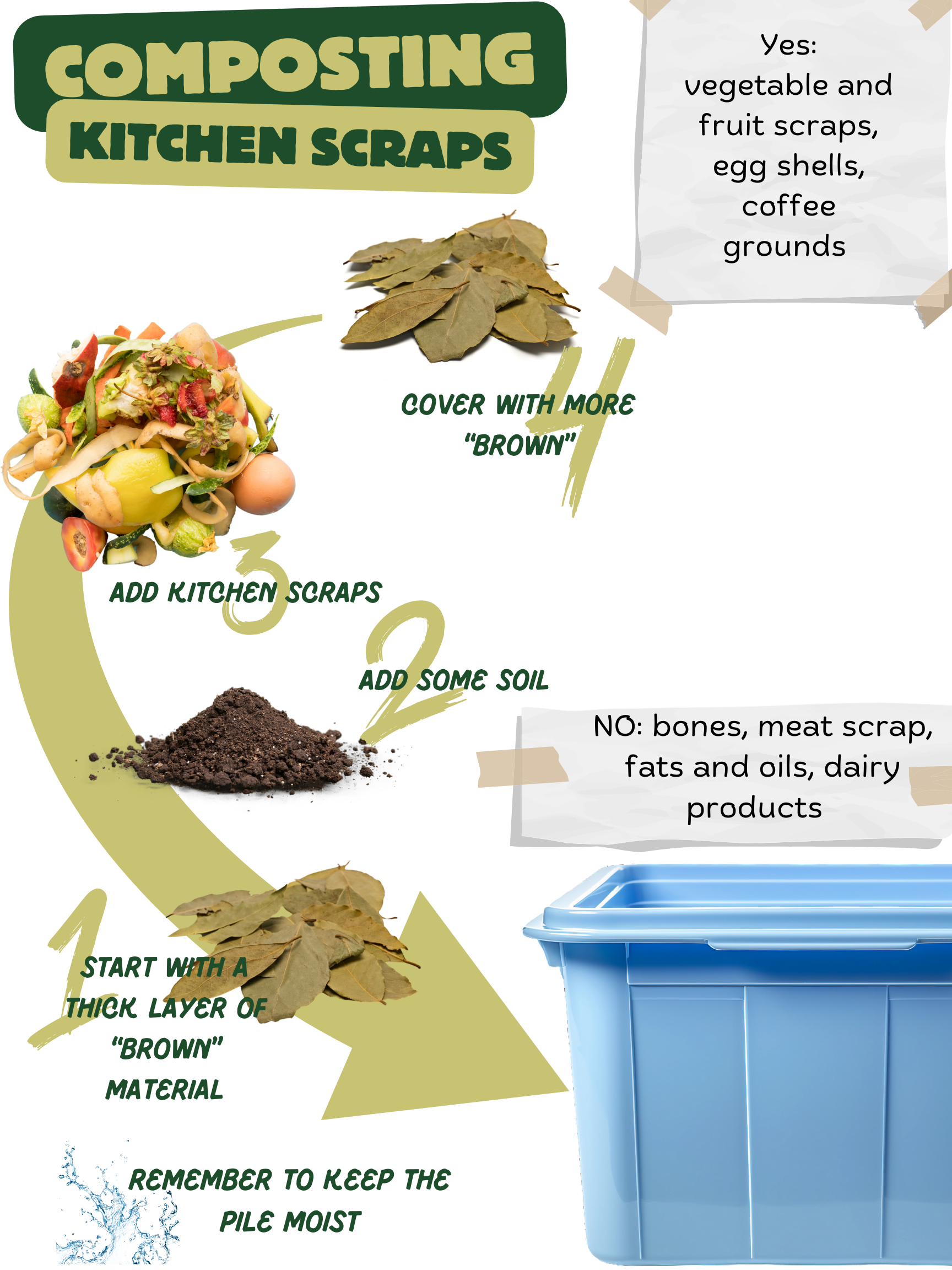 Example of garden compost bin. |
Composting is a wonderful strategy to create a free and nutrient-rich soil amendment usable in your garden and houseplants. Manure and bedding, household food waste, grass clippings, and leaves are perfect additions to a compost pile. In addition to the value of compost for your soils, composting kitchen scraps reduces waste and also gives you control over what goes in the compost you use for your garden. Store-bought compost, especially those made from animal manure can have high levels of salts, which can be damaging for garden plants.
Agricultural wastes like manure, bedding, crop residues and even animal mortalities can also be composted and spread on the field at agronomic rates as a means to:
- Improve soil health
- Reduce nutrient loads into the field
- Prevent soil and water nutrient contamination
How can I start a backyard compost pile?
A large plastic bin with a lid is a often good enough to start composting. Make sure to drill holes at the bottom of the bin for better drainage. Start by adding a layer of “brown” materials like dried leaves or shredded newspaper. These materials are rich in carbon (C), which provides organisms with energy to decomposte organic matter. You can also add a small layer of soil from your garden or older compost into the mix to introduce more organisms into the pile.
After adding the brown materials into the pile you can add your “green” layer, which consists of your kitchen scraps such as vegetables or fruits, dead plants, egg shells or coffee grounds. These materials are rich in nitrogen (N) and will speed the decomposing process. After you have placed those materials you can add another layer of browns to cover the pile. Ideally a compost pile should have a C:N ratio of 20:1 (or 40:1 for rapid decomposition), although backyard compost can often have C:N ratios of 10:1. Remember to keep the pile moist but not too wet.
A well-maintained pile reaches temperatures of 130° to 160° F. If the pile is not heating up, mix in greens and turn the pile. Mixing the pile periodically will speed the decomposition process as it aerates the pile. Monitor the pile moisture, temperature and odor and add materials or water as needed.
If you are having issues with your compost pile the CMG GardenNotes #246 can give you a few ideas of how to torubleshoot your compost.
- ATTRA Soils and Compost info
- CMG Garden Notes: Using Compost in Colorado Gardens.
- CDA regulations about composting agricultural wastes
Worm Composting
- Success Tips for Vermicomposting
- DIY Worm Composting Bin – Vermicompost.net
Manure Composting
Manure from the barn can be composted. For compost to work, the proper ingredients are needed:
- About 30:1 Carbon: Nitrogen ratio. Carbon source (bedding, grass clipping, leaves, shredded office paper) and Nitrogen source (manure).
- Air, created by turning regularly
- Water to 50% (feels like a wrung out sponge).
- Time
- Bacteria that will break down the material. They are naturally occurring in soil and manure.
Locate your compost pile out of natural drainages and away from wells. Think about keeping the clean water from running through the pile when it rains or snow melts.
Build the pile layering bedding and manure. Throw in a little soil to introduce bacteria that will break down the material. Water and wait. Use a composting thermometer to gauge the inside temperature. When it reaches 140 degrees, give it a turn and water as needed. Let the temperature rise again and turn it. Do this through at least 3 heating cycles. Don’t forget to water if needed (you may even want to cover the pile with a tarp if it dries out too quickly). The manure should look like soil when it’s finished. Allow it to cure for 6 months before use.
How to use composted manure?
On fruit or vegetable gardens
As described earlier on this page, compost can be a great way to supply nutrients and soil amendments to garden beds if done properly. The University of Idaho Extension recommends applying composted manure at least 60 days before harvesting vegetables that will be consumed raw. The best time to apply composted manure is in the fall to allow breakdown of pathogens before planting a garden in the spring.
New study on compost application on irrigated pastures in Colorado.
A recent three-year study in Western Colorado was made to evaluate the efficacy of compost applications on irrigated pastures. The goal was to test yields, soil organic carbon and soil health from compost applications compated to synthetic fertilizers, a combination of fertilizer and compost and pastures with no fertilizer or compost. Results No differences were detected in soil organic carbon and soil health metrics after 2 years across treatments and overll, compsoted plots were less productive compared to fertilized plots.
The benefits of utilizing compost on irrigated pastures need to be evaluated on a case by case basis, considering the goals for the application of compost. More informaiton on this research can be found here.
CSU Factsheets
SAM Newsletter Articles on Compost
- Composting 101 – summer 2020
- The Facts About Compost Tea – spring 2016
- Manure: A Renewable Resource – summer 2010
- Reducing Your Trash – winter 2011
- Worms In My Kitchen – spring 2009

Example of manure composting system. Newest manure is added in the left bin. Finished compost is in the far right bin. Moving the manure will aerate the pile. Piles must also be watered.
Use a long composting thermometer to monitor the internal temperature of your pile.






